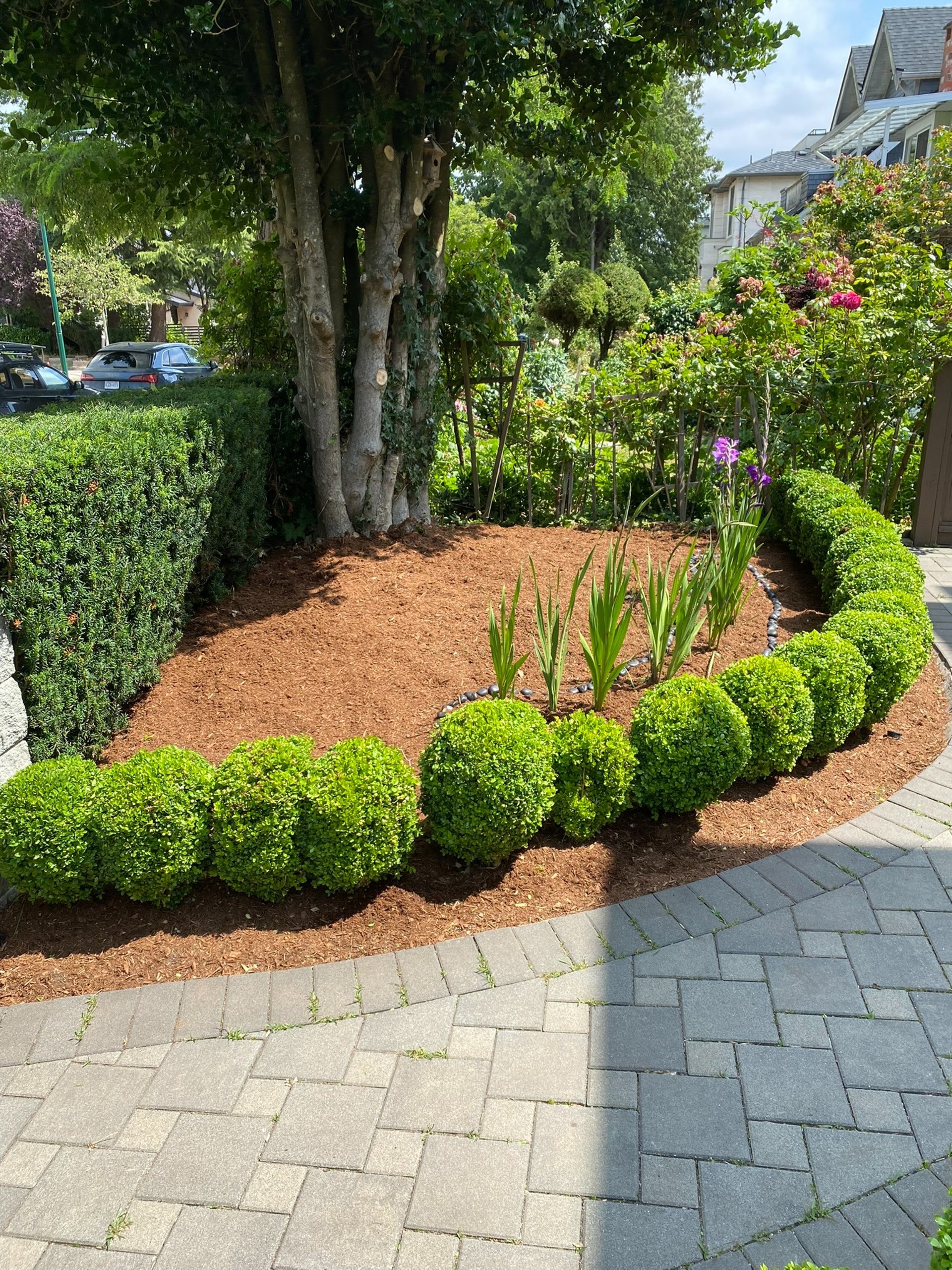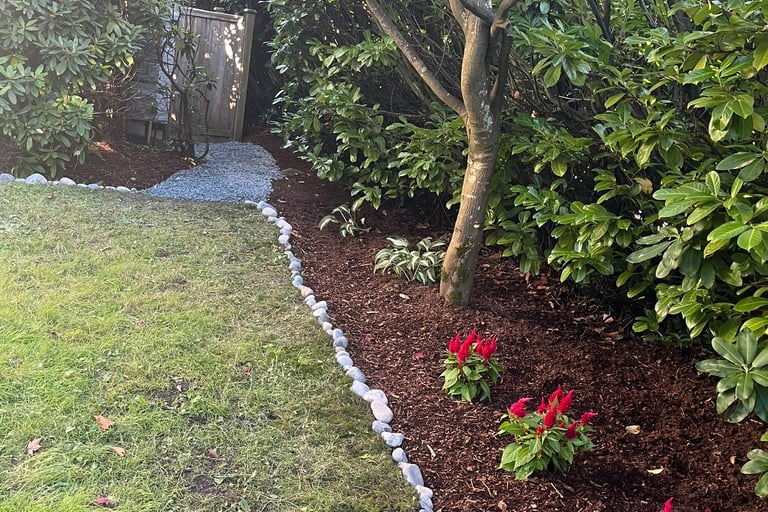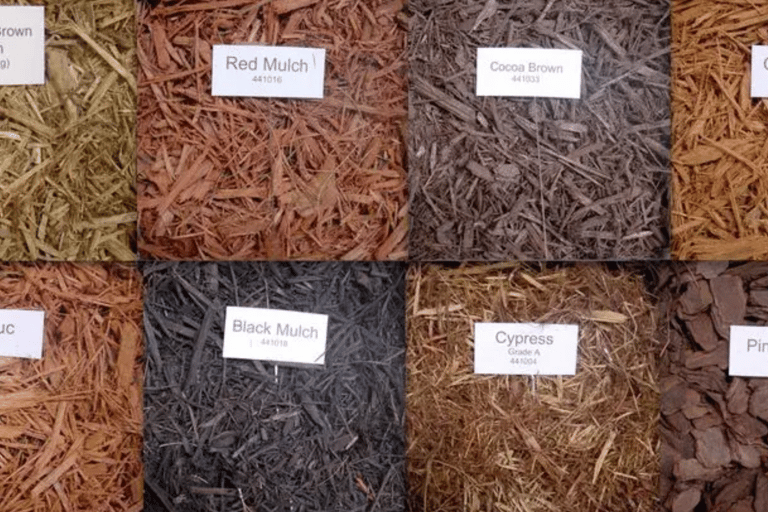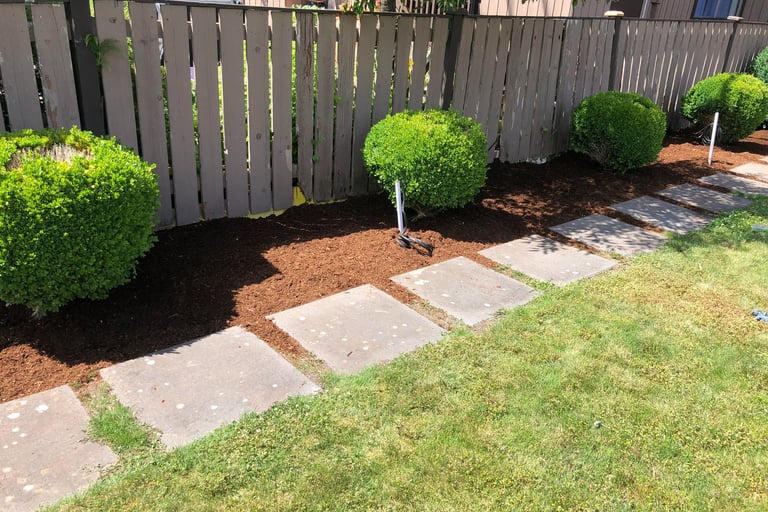
Mulch Depth Guidelines for Vancouver Plants: A Professional's Guide to Perfect Layering
Learn the ideal mulch depths for Vancouver gardens from expert landscapers. Discover how proper mulching techniques protect plants in our unique Pacific Northwest climate.
2/8/20256 min read
Understanding Mulch Depth in Vancouver's Unique Climate
As a professional landscaper with over 15 years of experience in Vancouver, I've seen firsthand how proper mulching can make or break a garden. If you're relocating to Vancouver with local movers, understanding our unique coastal climate, characterized by wet winters and increasingly dry summers, makes mulch depth understanding particularly crucial for plant health. In this comprehensive guide, I'll share professional insights on how to determine and maintain the right mulch depth for various plants in Vancouver's distinctive growing conditions.
The Vancouver Mulching Challenge
Vancouver's climate presents specific challenges that make proper mulch depth critical. With an average of 169 days of rain per year according to Environment Canada's historical data, and increasingly hot, dry summers, finding the right balance is essential. Too much mulch can lead to root rot during our wet seasons, while too little won't provide adequate protection during our dry spells.
Why Mulch Depth Matters in Vancouver Gardens
The right mulch depth is crucial for several reasons, particularly in our local climate. According to the UBC Botanical Garden, proper mulching helps maintain soil moisture, suppress weeds, and regulate soil temperature - all critical factors in Vancouver's variable weather conditions. Our mild winters and wet springs create perfect conditions for weed growth, making proper mulch application essential for garden maintenance.
Basic Mulch Depth Guidelines for Vancouver Plants
Trees and Large Shrubs
In Vancouver's climate, mature trees and large shrubs benefit from a 3-4 inch layer of mulch. However, this depth should be adjusted based on specific locations. For instance, trees in Stanley Park naturally benefit from leaf litter, but urban street trees need careful mulching to thrive in more challenging conditions.
Perennial Beds
For perennial beds, especially those featuring native plants like Pacific Bleeding Heart and Western Columbine, maintain a 2-3 inch layer of mulch. This depth provides adequate protection while allowing proper air circulation, crucial in our humid climate.
Vegetable Gardens
Vancouver's vegetable gardens require special consideration. A 1-2 inch layer of fine mulch works best, allowing for proper water penetration during our dry summers while preventing soil compaction during heavy winter rains.
The Critical Mulch-Free Zone
One of the most common mistakes I see in Vancouver gardens is mulch piled against tree trunks and plant stems. This practice, often called "volcano mulching," can be devastating in our wet climate. Always maintain a 3-6 inch mulch-free zone around tree trunks and a 1-2 inch space around plant stems. This spacing is particularly important given Vancouver's high annual rainfall, as it prevents moisture-related bark damage and root rot.
Seasonal Mulch Considerations
Spring Mulching
The best time to apply mulch in Vancouver is typically late March to early April, after the worst of our winter rains but before the summer drought stress begins. This timing allows the soil to warm naturally while retaining crucial spring moisture. The Vancouver Park Board's gardening guidelines recommend waiting until soil temperatures reach at least 8°C (46°F) before applying spring mulch.
Summer Mulching Practices in Vancouver
During Vancouver's increasingly hot summers, proper mulch depth becomes even more critical. Recent climate data from Metro Vancouver shows our summers are becoming warmer and drier, with July and August temperatures regularly exceeding historical averages. This shift requires adaptive mulching strategies to protect our plants.
Native Plant Considerations
When mulching around native plants like Salal, Oregon Grape, or Sword Ferns, maintain a 2-3 inch layer of organic mulch. These plants have evolved to thrive in our local ecosystem, and according to the Native Plant Society of British Columbia, they benefit from mulch that mimics their natural forest floor environment.
Choosing the Right Mulch Material for Vancouver Gardens
Organic Mulch Options
Cedar Mulch
In Vancouver's wet climate, cedar mulch is particularly effective due to its natural resistance to decay. Apply it 3-4 inches deep for optimal results. The Vancouver Tree Company notes that cedar mulch's natural oils help repel many local pest species while breaking down slowly in our wet conditions.
Leaf Mulch
Fall leaves from our abundant deciduous trees make excellent mulch. When using leaf mulch, compress it to a 2-3 inch layer to prevent matting during our wet winters. The decomposition rate is perfect for our growing season.
Pine Needles
For acid-loving plants common in Vancouver gardens, such as rhododendrons and blueberries, pine needle mulch at a 2-3 inch depth provides ideal conditions. This mulch type is particularly effective in our region's naturally acidic soils.
Professional Application Techniques
The Two-Layer Approach
In Vancouver's climate, I often recommend a two-layer mulching technique:
Bottom Layer
Apply a 1-inch layer of finely shredded organic matter directly on the soil. This layer decomposes quickly, feeding the soil ecosystem that's particularly active in our mild climate.
Top Layer
Add 2-3 inches of coarser mulch on top. This layer provides longer-lasting protection against our extreme weather patterns, from heavy winter rains to summer drought.
Mulch Depth for Specific Garden Types
Rain Gardens
With the increasing implementation of rain gardens in Vancouver, proper mulch depth is crucial for managing our significant rainfall. The City of Vancouver's Green Infrastructure guidelines recommend a 3-inch layer of hardwood mulch for rain gardens, allowing for proper water filtration while preventing soil erosion.
Japanese Gardens
For Vancouver's many Japanese-inspired gardens, like the one at Nitobe Memorial Garden, maintain a thinner 1-2 inch layer of fine mulch around ornamental plants and moss gardens. This approach respects the aesthetic while providing necessary protection.
Adjusting Depth for Slope Gardens
Many Vancouver properties feature sloped gardens due to our city's topography. On slopes:
• Reduce mulch depth to 2 inches on steep inclines to prevent slippage during heavy rains
• Use coarser mulch materials that lock together
• Consider incorporating jute netting under the mulch for additional stability
Maintaining Proper Mulch Depth Throughout Vancouver's Seasons
Monitoring and Adjusting
In Vancouver's dynamic climate, mulch depth requires regular monitoring. The West Coast Seeds Growing Guides recommends checking mulch depth monthly during the growing season. Our heavy winter rains can compress mulch, while summer's dry spells might require additional layers for adequate moisture retention.
Winter Mulch Management
During Vancouver's wet season (November through March), pay special attention to mulch depth around sensitive plants. Excessive moisture retention can lead to root rot, a common problem in our climate. Consider reducing mulch depth by an inch around plants susceptible to winter damage.
Professional Tips for Long-term Success
Mulch Decomposition Rates
Understanding decomposition rates in Vancouver's climate is crucial for maintenance:
• Cedar mulch typically lasts 2-3 years in our climate
• Leaf mulch breaks down within one season
• Bark mulch usually needs replenishment annually
The Vancouver Master Gardeners Association suggests monitoring the decomposition rate and adding fresh mulch when the layer reduces to less than 1 inch thick.
Common Vancouver Mulching Challenges and Solutions
Fungal Growth Management
Our wet climate often leads to fungal growth in mulch. While most mushrooms are harmless and actually beneficial, excessive growth might indicate over-mulching. The UBC Faculty of Forestry research shows that maintaining proper air circulation by keeping mulch depth at 3 inches or less helps prevent problematic fungal growth.
Dealing with Local Pests
Vancouver's mild climate supports various mulch-dwelling insects. While most are beneficial, some can damage plants. Maintain a mulch-free zone around woody stems and regularly inspect for pest activity, particularly during our mild winters when some insects remain active.
Special Considerations for Vancouver's Micro-Climates
North Shore Gardens
Properties near the North Shore mountains typically receive more rainfall. In these areas, reduce standard mulch depths by 1 inch to prevent water logging.
South-Facing Slopes
Gardens on south-facing slopes, particularly in areas like West Vancouver, may need an extra inch of mulch to combat increased sun exposure and faster moisture loss.
Professional Maintenance Schedule
Spring (March-May):
• Assess winter damage
• Replenish mulch to appropriate depths
• Check for compaction from winter rains
Summer (June-August):
• Monitor moisture retention
• Add mulch as needed during dry spells
• Check for proper depth around irrigation systems
Fall (September-November):
• Adjust depths before winter rains
• Remove excess mulch where needed
• Prepare sensitive plants for winter
Winter (December-February):
• Monitor for mulch displacement during heavy rains
• Check for proper drainage
• Maintain mulch-free zones around tree trunks
Frequently Asked Questions
Q: How often should I replace mulch in Vancouver's climate?
A: Generally, organic mulch needs replacement every 1-2 years in Vancouver. However, cedar mulch may last up to 3 years due to its natural resistance to our wet conditions.
Q: Should I remove old mulch before adding new layers?
A: In Vancouver's climate, remove old mulch if it's showing signs of compaction or decomposition that might impede drainage during our wet seasons. Otherwise, lightly rake existing mulch before adding a new layer.
Q: What's the best mulch depth for winter protection in Vancouver?
A: Maintain 2-3 inches for most plants, but reduce to 1-2 inches around plant bases to prevent moisture-related issues during our wet winters.
Q: How should I adjust mulch depth during drought conditions?
A: During Vancouver's increasingly dry summers, increase mulch depth by 1 inch, but maintain proper spacing around plant stems and tree trunks.
Proper mulch depth is crucial for plant health in Vancouver's unique climate. If you're unsure about the specific needs of your garden or would like a professional assessment, contact our experienced team. We provide customized mulching services that take into account your property's specific microclimate and plant varieties. Schedule a consultation today to ensure your garden thrives year-round in Vancouver's challenging conditions.
For more information about our professional mulching services or to schedule a garden assessment, visit our website or call us directly. Let us help you maintain the perfect mulch depth for your Vancouver garden's specific needs. Or check out or Vancouver Landscaping Blog.






Contact
Blossomscaping@gmail.com
+1-604-339-9217
© 2024. All rights reserved.
Where we service
3158 W 34th Ave, Vancouver, BC V6N 2S2
UBC - Cambie - Dunbar - West Vancouver - North Vancouver - West Point Grey - Shaughnessey - Richmond - Kerrisdale - South Vancouver - East Vancouver - Kitsilano - Burnaby - Mount Pleasant - Oakridge - Arbutus Ridge - Marpole - Southlands - Victoria-Fraserview


Proudly Servicing Vancouver, British Columbia
What we service
